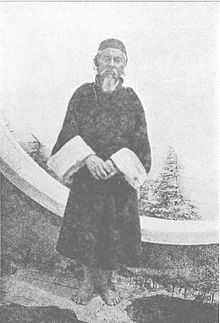Kinthup

Kinthup, a Lepcha man from Sikkim, was an explorer in the area of Tibet in the 1880s. He is best known for his impressive devotion to duty in surveying a previously unknown area of Tibet.[1]
In the 1870s, the destination of the Tsangpo River (sometimes spelled "Sanpo") was unknown. Some hypothesized that it was the same river that flowed into the Bay of Bengal under the name of Brahmaputra (also known as "Dihang"). To solve this mystery, the colonial government of India sent a pundit explorer, known only as "G. M. N." to follow the Tsangpo and determine its ultimate destination. G. M. N. was accompanied by his assistant, a Sikkimese lepcha named Kinthup. After surveying a good portion of the river, the pair returned to India.[1]
In 1880, a Chinese lama was employed to continue G. M. N.'s work, and Kinthup was again hired to accompany him.[1] In 1880 Kinthup was sent back with the task of testing the Brahmaputra theory by releasing 500 specially marked logs into the river at a prearranged time at which Captain Henry Harman, his British boss, posted men on the Dihang-Brahmaputra to watch for their arrival.[2] However, in May 1881 the Chinese lama sold Kinthup to a Tibetan lama to become his slave. Kinthup's surveying equipment and notebooks were confiscated and he remained a slave until March 1882, when he finally managed to escape.[1] Only then was he able the prepare the logs, send a letter from Lhasa announcing his new intended schedule, and launch the logs. Four years had passed. Unfortunately his note to alert the British got misdirected, his boss had left India, and nobody checked for the appearance of the logs.[2]


To start on his way back home he had to travel east along the Tsangpo and sought sanctuary in a Buddhist monastery where he was welcomed by the head lama.[1] Kinthup continued with his surveying over the course of two and a half years under the guise of religious pilgrimages. He made several long treks recording the extent of the Tsangpo and surrounding region, and determining that the two rivers were indeed one and the same. Finally, in November 1884, he reached India.[1] It was not until two years later that his account was even recorded, and even then his extraordinary accounts were doubted by some geographers.[1] It was only some 30 years later that the Bailey–Morshead exploration of Tsangpo Gorge conclusively confirmed his discovery.[1]
References
- ↑ 1.0 1.1 1.2 1.3 1.4 1.5 1.6 1.7 Burrard, S. G. (1915). "The Identity of the Sanpo and Dihang Rivers" (PDF). Bulletin of the American Geographical Society (American Geographical Society) 47 (4): 249–264. Retrieved 2012-09-17.
- ↑ 2.0 2.1 Allen, Charles (1982). A Mountain in Tibet: The Search for Mount Kailas and the Sources of the Great Rivers of Asia. London: Abacus.